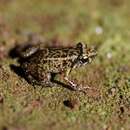ar
الأسماء في صفحات التنقل


The subgenus Syrrhophus as currently recognized (Hedges et al. 2008) contains 26 species of small (20-40 mm), terrestrial, direct-developing frogs that occur from Texas through Mexico and into Guatemala and Belize, with two species in western Cuba. Like other members of the Terrarana (Hedges et al. 2008), these frogs reproduce on land and have direct development. They inhabit a variety of different habitats along elevational gradients from sea level to about 2,000 meters, and are characterized by considerable microendemism, with several species known only from the type locality (IUCN 2012). Members of this group have had an unstable taxonomic history (reviewed in Lynch, 1970). In part, this taxonomic confusion stems from overall morphological conservatism among Syrrhophus species, and a history of delimiting species using evolutionarily plastic characters such as color pattern, skin texture, relative digit length, and size of digital discs (Dixon 1957; Lynch 1970; Hedges et al. 2008).
Members of this group were previously placed in two separate genera, Syrrhophus and Tomodactylus (Smith and Taylor 1948). Lynch (1968, 1970, 1971) maintained these genera as distinct, and discussed differences separating them from Eleutherodactylus. Hedges (1989) proposed that species previously placed in the genera Syrrhophus and Tomodactylus be placed in the subgenus Syrrhophus based on osteological similarities (Lynch 1971). Heinicke et al. (2007) found that two species from western Cuba formerly assigned to the subgenus Euhyas, E. symingtoni and E. zeus, grouped with the mainland Eleutherodactylus (Syrrhophus) marnockii in their phylogenetic analysis, and as a result, transferred them to the subgenus Syrrhophus. Their presence in Cuba suggests mainland Syrrhophus arose through dispersal from Cuba (Hedges 1989; Hass and Hedges 1991; Heinicke et al. 2007).
Hedges et al. (2008) conducted a monographic revision of New World direct developing frogs using DNA sequences, including three (of 24) mainland species of Syrrhophus in their phylogeny. They recognized the mainland and Cuban clades as informal "species series", the E. longipes series (24 species) and E. symingtoni series (two species), respectively. Within the E. longipes series, species were placed into six species groups defined by Lynch (1970): the E. leprus, E.longipes, E.marnockii, E.modestus, E.nitidus, and E.pipilans species groups (Hedges et al. 2008).
AmphibiaWeb provides access to information on amphibian declines, natural history, conservation, and taxonomy. This is a link to the family Eleutherodactylidae.
A link to a project on iNaturalist for recording observations of frogs of the subgenus Syrrhophus.